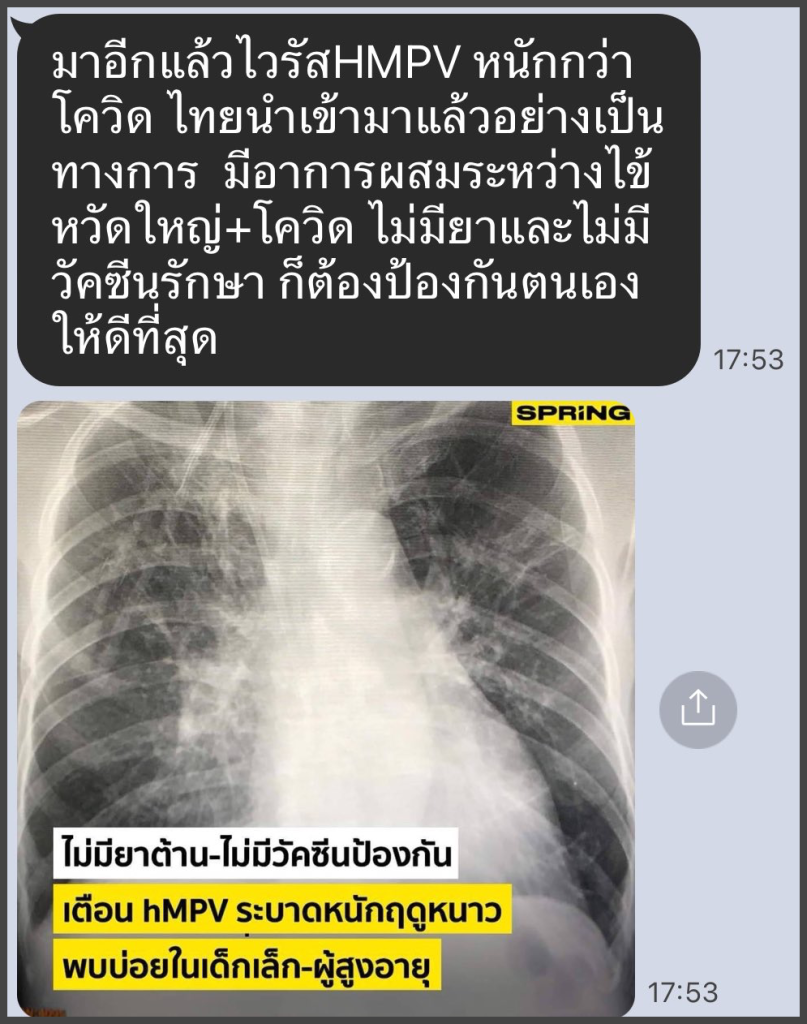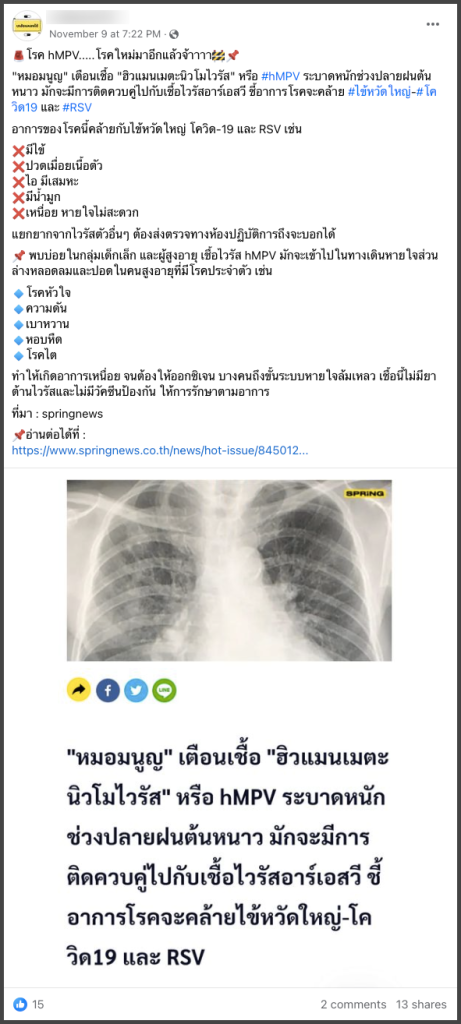
In an age where information spreads rapidly, the internet has become a hub for both knowledge and misinformation. This is particularly true in the realm of health, where sensational claims often capture attention. Lately, there has been a surge of panic on online platforms, driven by the claim that a new virus, hMPV, is emerging.
Post on Social Media
We found a message circulating on the LINE platform stating, “Here it comes again, the HMPV virus is more severe than COVID. It has officially been imported to Thailand. It presents symptoms that are a combination of severe flu and COVID-19. There is no treatment or vaccine available, so we must protect ourselves as best as we can.”

In addition, we also found similar claim on Facebook suggesting that hMPV is the new virus.

However, we found that the statement above may cause misunderstandings and concerns for readers. In fact, hMPV is not a new disease at all.
What is hMPV?
Human Metapneumovirus (hMPV) is a type of virus that causes respiratory tract infections. Its symptoms, such as fever, cough, and runny nose, are similar to those of a common cold. This virus has been known for many years and is not a new strain. However, its recognition in Thailand is recent, thanks to the development of easier and faster testing methods. Laboratory testing, using a swab similar to the method employed for influenza and RSV virus detection, can identify the virus.
Individuals infected with this virus experience respiratory-related symptoms, similar to those of a common cold. These symptoms include fever, cough, runny nose, and sore throat. These manifestations are frequently observed in young children under the age of 5 and elderly individuals. In adults and older children with a strong immune system, the infection may manifest as a mild cold or may even be asymptomatic. (Source: Assoc. Prof. Dr. Raweerat Sitcharungsi)
According to information from the Centers for Disease Control and Prevention (CDC), Human Metapneumovirus (hMPV) was discovered in 2001 and belongs to the Pneumoviridae family, similar to Respiratory Syncytial Virus (RSV).
Symptoms and Infection
Common symptoms of hMPV include cough, fever, nasal congestion, and difficulty breathing. Infection with hMPV can result in bronchitis or pneumonia and can cause upper and lower respiratory tract infections similar to those caused by other viruses. The incubation period is usually around 3 to 6 days, and the duration of symptoms may vary depending on the severity of the infection. However, in general, the symptoms are similar to those of other respiratory tract infections caused by viruses.
hMPV (Human Metapneumovirus) can cause upper and lower respiratory tract infections in people of all ages, especially in young children, the elderly, and those with weakened immune systems. There is a tendency for the virus to spread from infected individuals to others, as follows:
- Respiratory droplets are released when someone coughs or sneezes.
- Close contact, such as touching or shaking hands.
- Touching surfaces that are contaminated with the virus and then touching the mouth, nose, or eyes.
Prevention and Treatment
Although there is currently no specific antiviral medication or vaccine for preventing hMPV, the main approach to treatment is supportive care based on the patient’s symptoms. In cases of severe pneumonia or severe wheezing, hospitalization may be necessary for treatments such as medication inhalation, lung tapping, mucus suction, or intravenous fluid administration (Source: Nakornthon Hospital).
To prevent hMPV infection, you can take the following measures:
- Wash your hands frequently and properly with soap for at least 20 seconds.
- Avoid touching your eyes, nose, or mouth with unwashed hands.
- Stay away from sick individuals and avoid close contact.
- If you have symptoms similar to a cold, cover your mouth and nose when coughing or sneezing.
- Avoid sharing cups and utensils with others.
- Minimize close contact with others.
- Stay at home and take care of yourself.
Distinction between hMPV and COVID-19
Although the symptoms of hMPV are somewhat similar to COVID-19 due to several shared similarities, common symptoms of both viruses include cough, difficulty breathing, runny nose, and fever. Additionally, both viruses spread in similar ways, primarily through person-to-person contact. This can occur through touch or contact with contaminated surfaces, as well as through the eyes, nose, mouth, or respiratory droplets from coughing and sneezing. The preventive measures for both viruses are the same, which include handwashing, cleaning surfaces or objects that have been touched, and staying at home when ill.
However, the difference between COVID-19 and hMPV is that currently, there is no vaccine or antiviral treatment available for hMPV, while COVID-19 has preventive vaccines and antiviral medications.
However, the difference between COVID-19 and hMPV is that currently, there is no vaccine or antiviral treatment available for hMPV, while COVID-19 has preventive vaccines and antiviral medications.
Follow us and stay up to date with our latest fact checks.
Facebook | Twitter | Instagram | LINE | TikTok

Title:hMPV is ‘not’ a new type of virus, as claimed on social media
Written By: Fact Crescendo TeamResult: Insight





